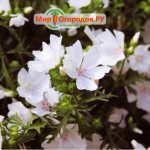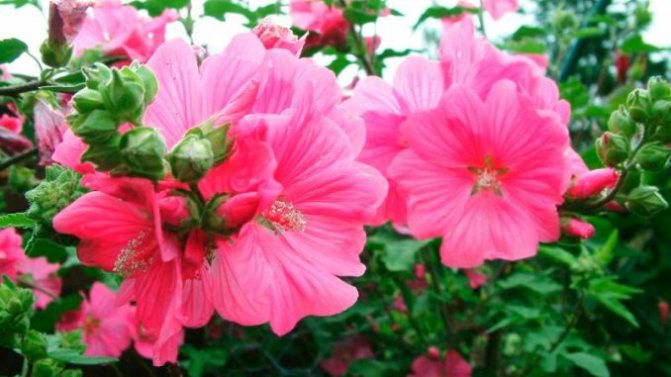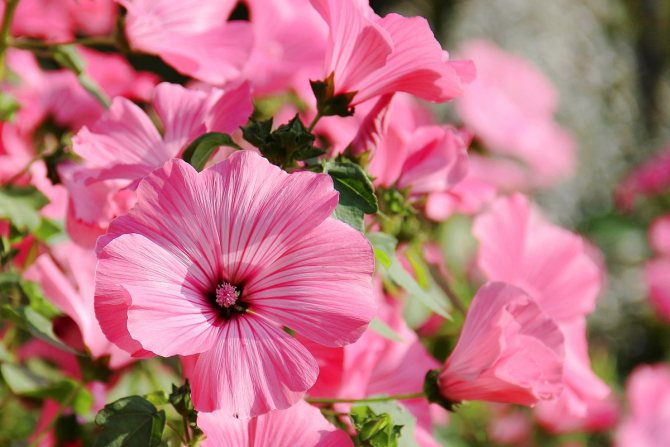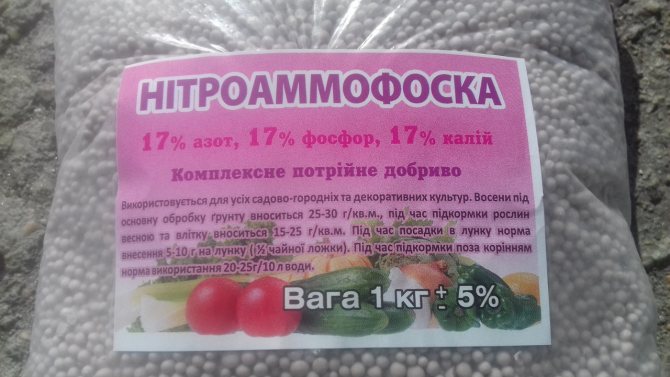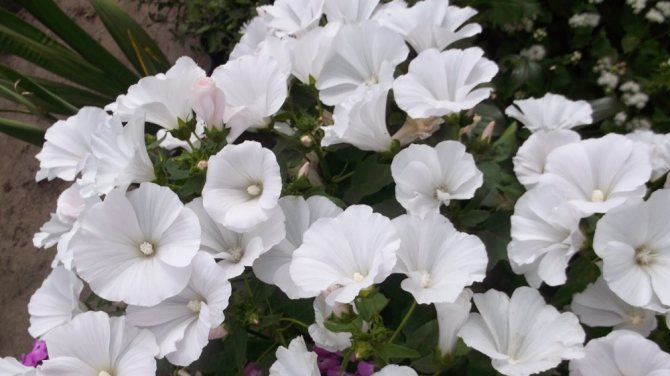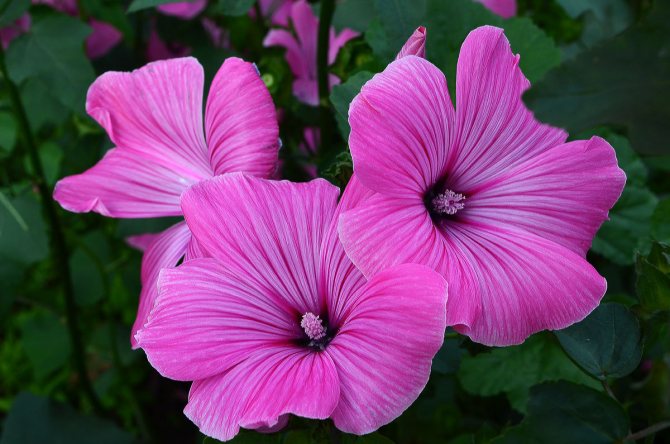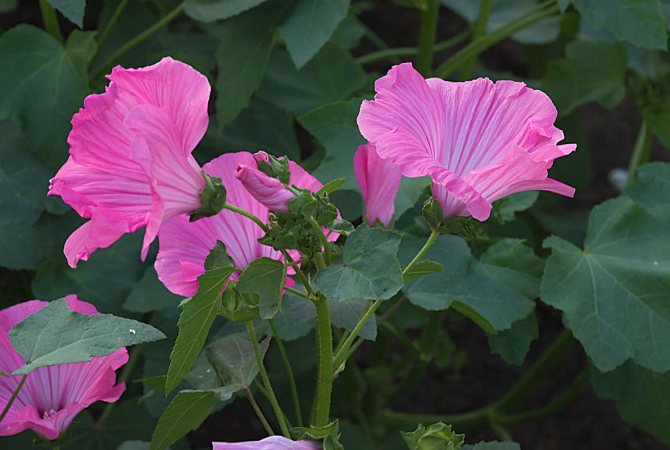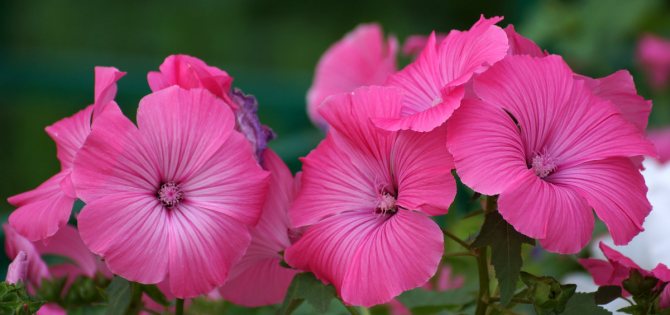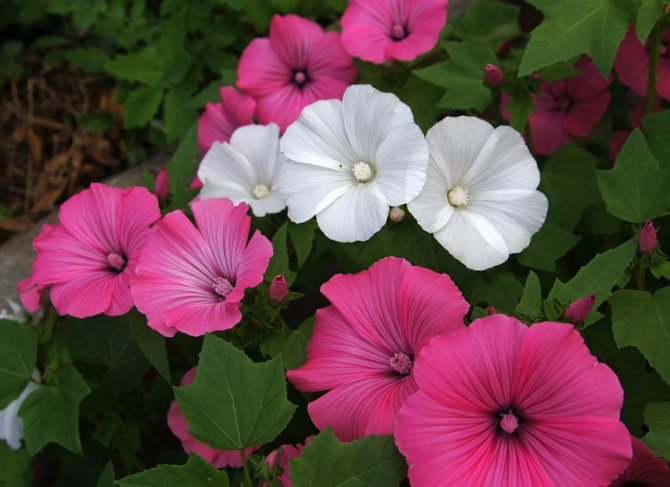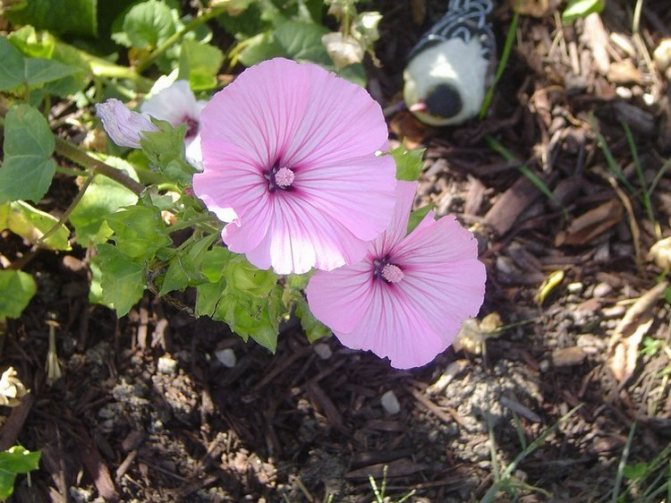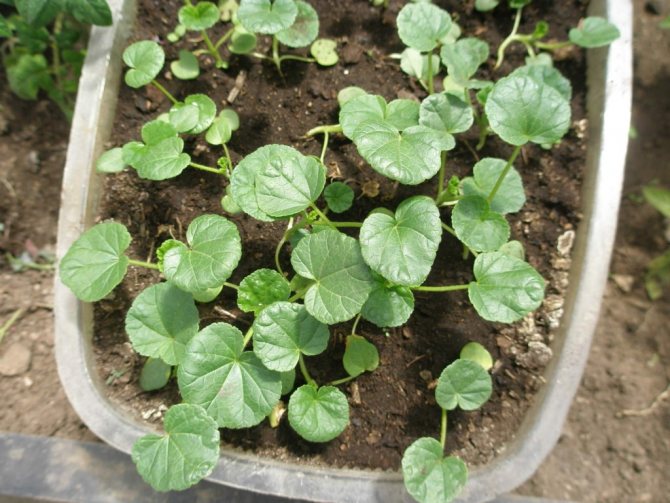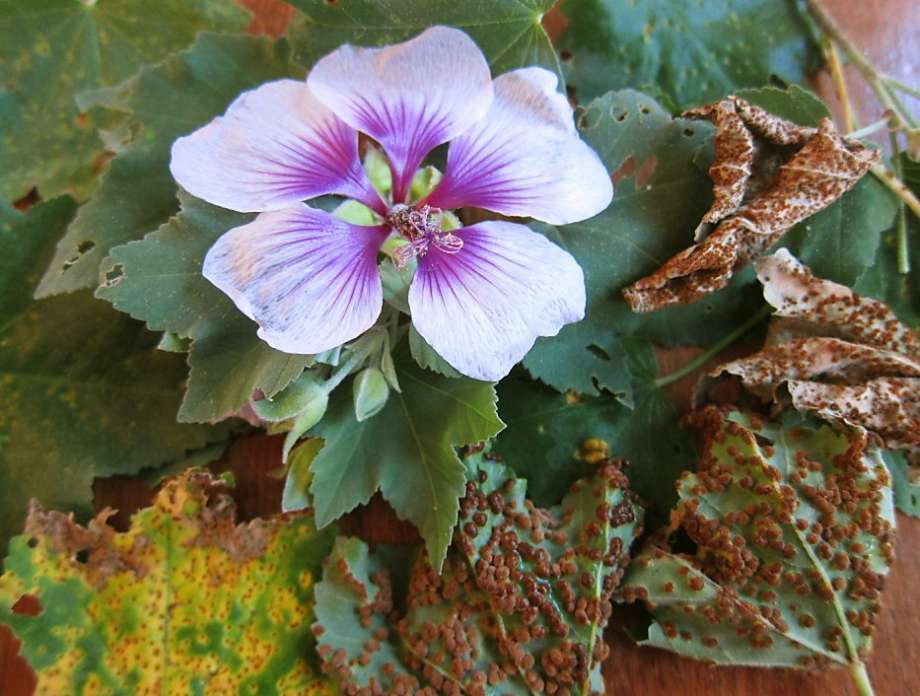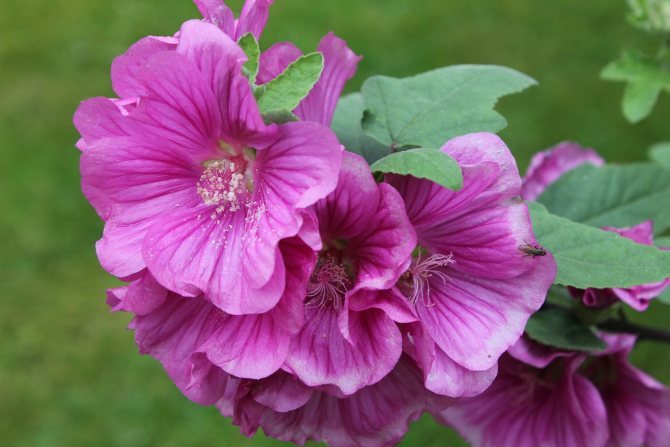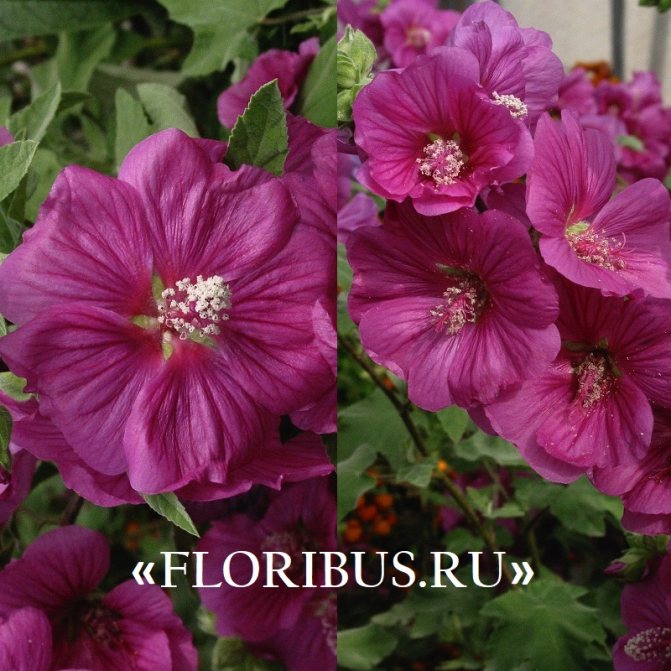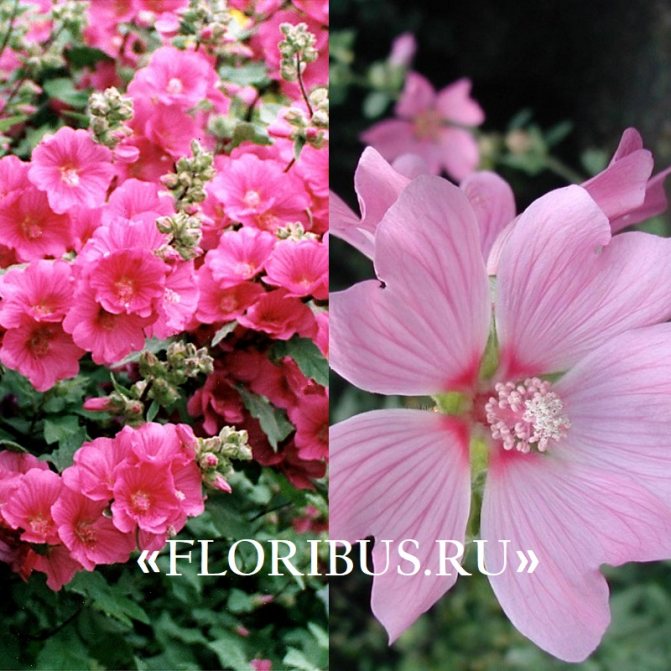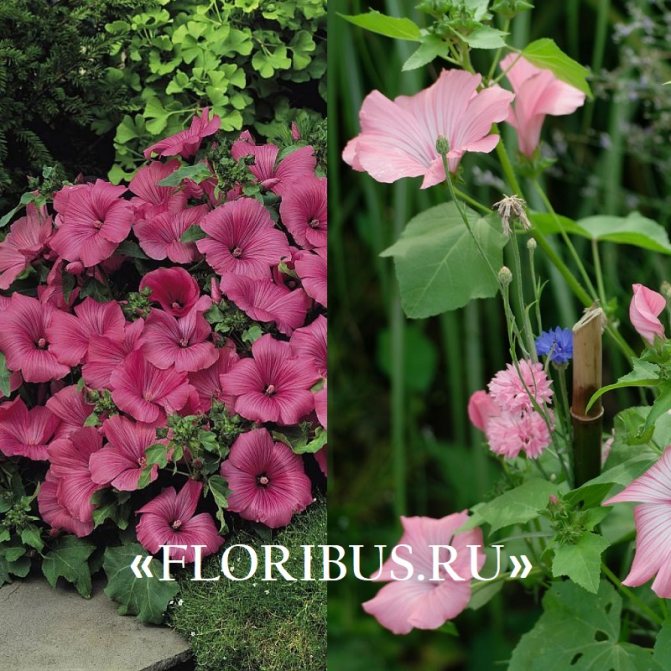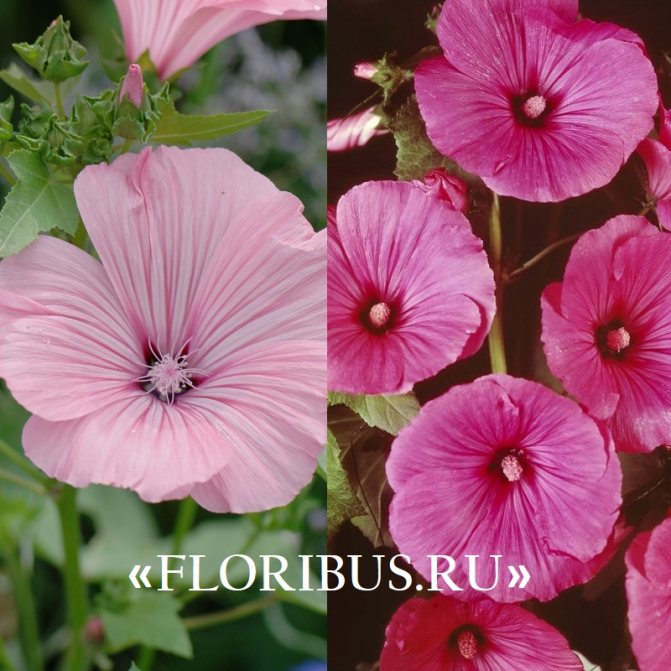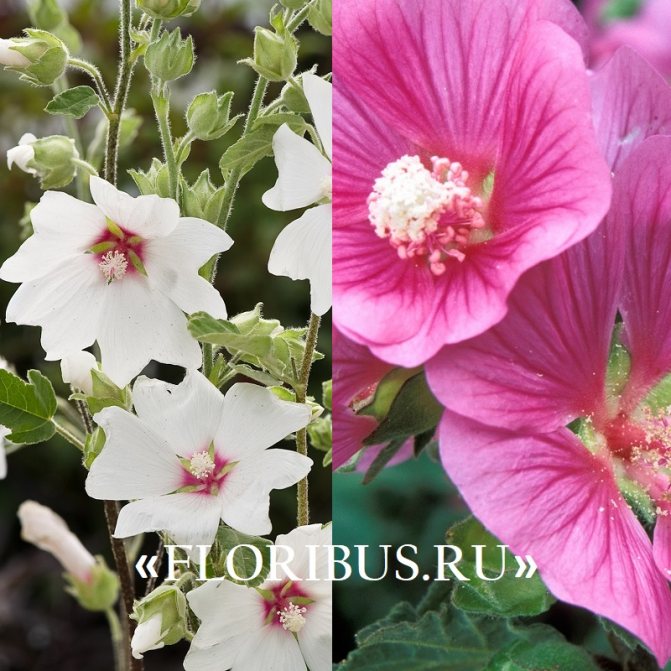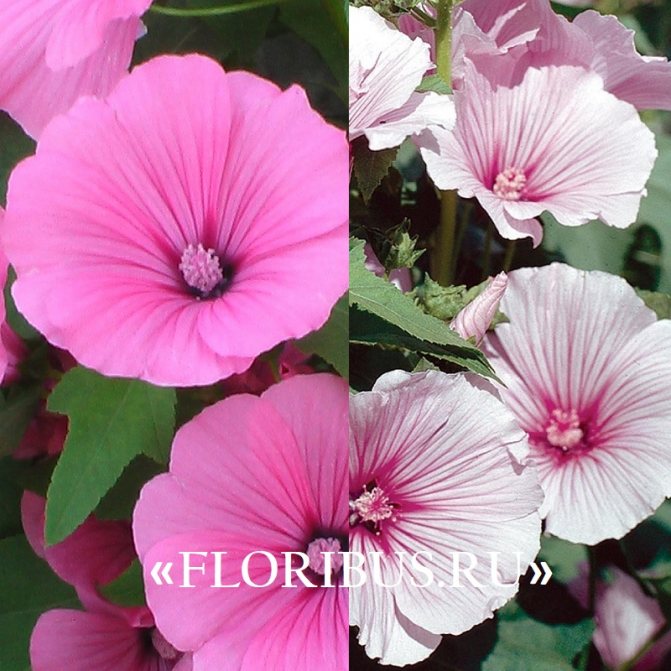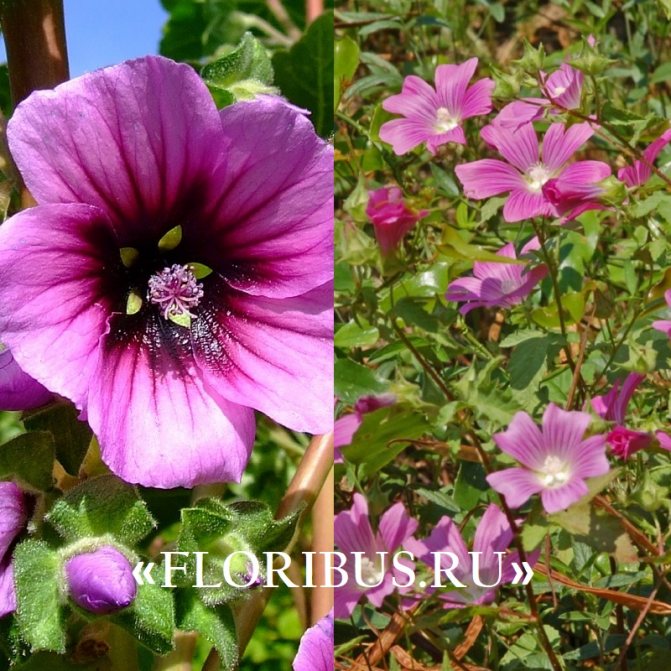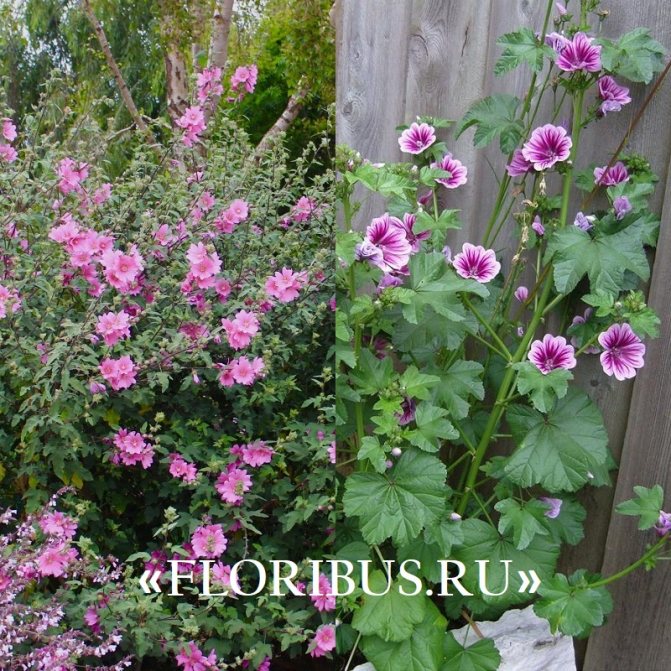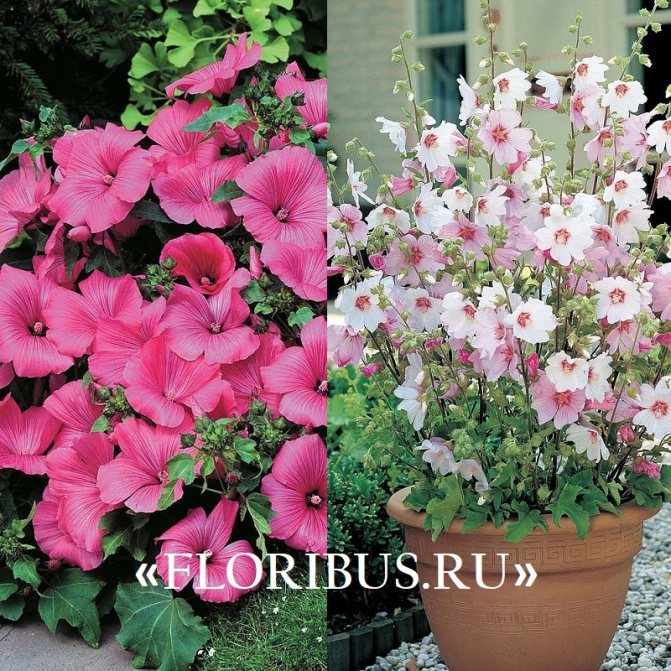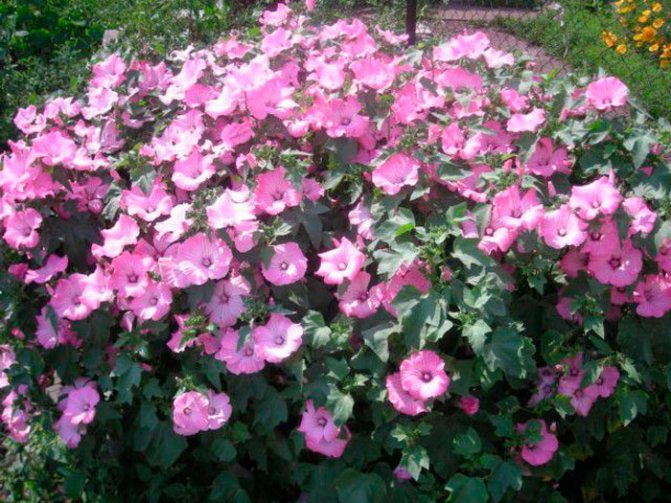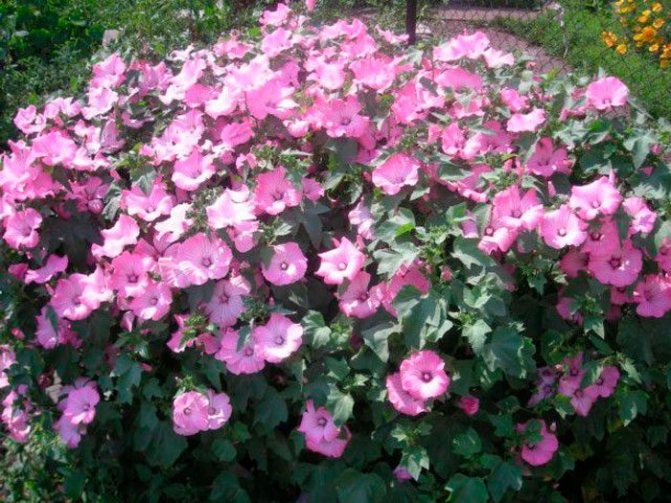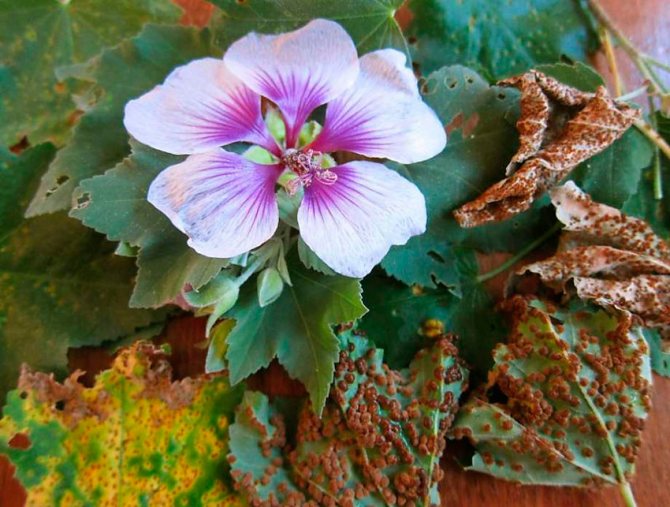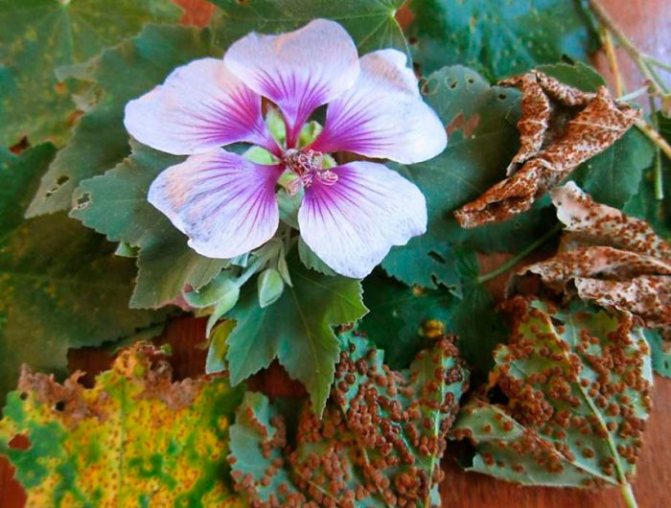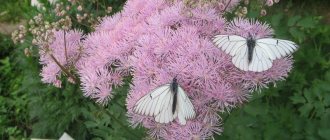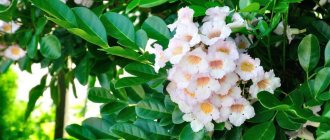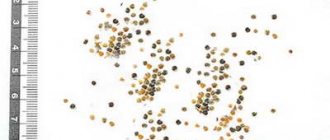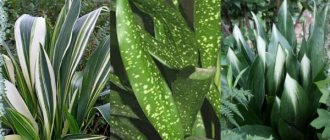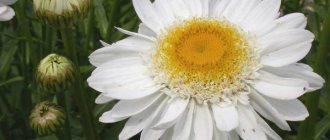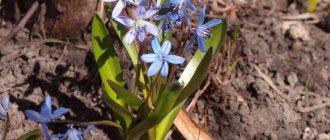The first impression of this flower is how touching and exquisite it is. Pure porcelain. Delicate white and pink silk. In fact, behind the fragile beauty is an unpretentious and quite modest annual with a name that caresses the ear - lavatera. He is a frequent visitor to the village front gardens, he is welcomed in the gardens of the so-called small care, but there is also a worthy place in the professionally designed landscape of the lavater.
In decorative floriculture, the southern guest has been used since 1620
Description of lavaters with photos of flowers
The genus Lavatera belongs to the Malvov family and is represented by annual and perennial flowering varieties. It can have a herbaceous, shrub, and in the southern regions and a tree-like form. It was brought into culture in the 17th century, and since then it has a consistently high demand due to its undemanding care and discreet, but pleasant-looking appearance. Currently, numerous varietal and hybrid lines of Lavater with improved decorative characteristics have been developed.
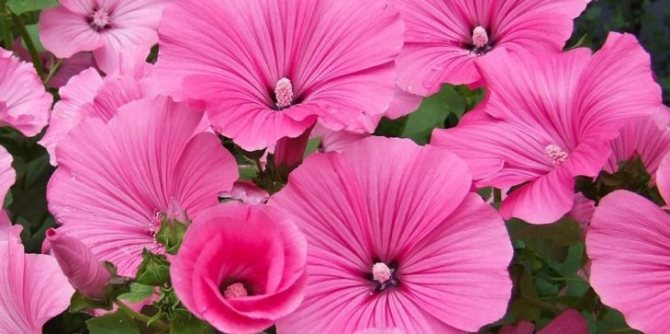
The height of the bushes can reach 1.5-2 m, but there are also compact varieties no higher than half a meter. The root system is well developed, the crown is strongly branched, strong. Lobe-shaped leaves, rigidly but shortly pubescent, arranged alternately. The flowers are large, with a five-leafed corolla, they can grow singly or in a row of several pieces, they are painted most often in pure colors (white, pink, yellow, burgundy, crimson), there are also variegated inflorescences in delicate halftones. The buds are located at the ends of the shoots, forming the final spike-shaped, rarely racemose inflorescences.
Flowering begins in June. The buds bloom on the shoots of the current year, and rise with them higher and higher as they grow, gradually decreasing in size. The last flowers can decorate the flower bed until mid-autumn.
Lavatera can be used for cutting, keeping it fresh in a vase of water for at least a week.
Breeding features
Perennial Lavatera reproduces in shifts, which freely spread over the adjacent territory. As a rule, they root well without outside help, which may cause a new flower bed to appear next season.
Therefore, in the fall, you need to especially carefully observe the plant. The seeds ripen in capsules that are green at first, then turn brown and fall to the ground. To be sure of their maturity, you need to open one box. If the seeds spill out freely, then they are ripe. They can be collected and stored at home.
Attention! The seeds are stored in a newspaper or bag made of natural breathable materials at room temperature, the room should be moderately humid
.
Varieties of lavater with a photo
The plant is represented by 25 species that grow in the wild mainly in the Mediterranean and East Asia. Some of them are from the Australian continent. In the climatic conditions of middle latitudes, only three varieties are cultivated, which are represented by annual, biennial and perennial lavater. Three more species can grow in gardens in more southern latitudes. The rest on European territory in open ground are not grown.
Lavatera three-month
One of the representatives of the annual culture.It grows quickly, reaching 1.2-1.5 m in height during the season. The lower leaves have a serrated edge and an oval-heart-shaped shape. The upper ones are smaller, carved, 3 or 5-bladed. The funnel-shaped corollas of the inflorescences reach 10 cm in diameter and are formed from the leaf sinuses. In the lower part of the stem, they are solitary, then, as they approach the apex, they become smaller and sit more often. Coloring of buds in pink-carmine tones.
The best varieties of the three-month lavater:
- Silver Cup. The buds are pink with a silvery sheen and well-defined burgundy veins. Stems up to 0.7 m.
- Mont Blanc. A low-rise variety with white flowers patterned with dark veins.
- "Ruby Queen". A strong, highly branched plant, reaching a meter in height. Blooms in a bright carmine palette.
- "Beautiful girl". Forms a powerful vigorous bush with large shiny flowers of white, pink, salmon color.
- "Goddess of the Sun". It is a mixture of tall varieties with medium-sized inflorescences of different colors.
- "Novella". Dwarf varietal variety, not exceeding 20 cm. Great for home container growing, landscaping balconies, etc. When planted in open ground, its stems grow slightly higher. The flowers are pink in color.
- White Sherub. Another undersized compact variety up to 35 cm, suitable for growing from seed as a pot crop. The buds are white.


For the early flowering of the annual lavater, the seedling growing method is recommended. Planting seeds and caring for seedlings are standard for all species.
Lavatera Thuringian
The popular name is dog rose. It is a representative of perennial varieties, which are characterized by the growth of the bush and the large size of the flower corollas. It can reach 2 or more meters. The best varietal lines:
- Lilac Lady is a lilac variety.
- "I Catcher" - the buds are painted in a deep pink palette.
- "Burgundy Vine" - a pattern of dark purple veins is clearly printed on the pink background of the petals.
- "Burgundy Baby" - blooms in delicate white and pink tones.
- "Bregon Springs" is not the tallest, about 1.3 m, but strongly branched bush with a lush crown, decorated with lilac-pink buds. It is valued for its particularly high drought resistance and long flowering, however, it does not have the best frost resistance. One of the few varieties of Lavatera that requires light shelter in winter.


Tree lavatera
It is the only representative of the two-year-old species introduced into culture. It has a well-defined powerful central trunk growing on nutrient soil up to 2 m. The lower leaves are oval, very large, up to 20 cm in length. The flowers are purple-pink with a dark color of the throat; among the varieties of tree-like lavater, there are also variegated colors. The best varieties are “Rosea” with dense pink corollas of buds and “Candy Floss”, which blooms in a pale pink color.
The next three species are grown in regions with mild winters or require extensive shelter during the cold season.
Lavatera Primorskaya
Another name is Bicolor, which was given to her for the two-color color of the petals strongly narrowed to the base. Usually it is a deep lilac color, which, with a transition to the edge, acquires a pale pink color.
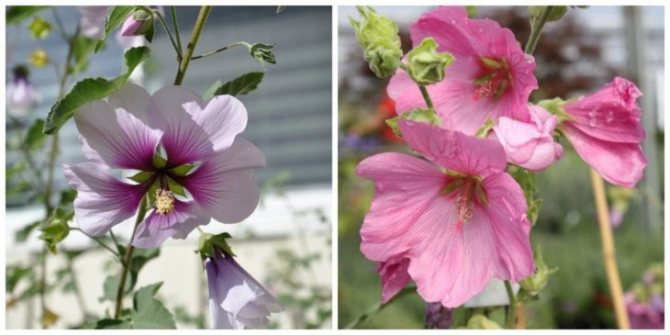

Lavatera Cretan
Mediterranean decorative tall species with upright powerful stems with a slight tomentose pubescence. The same hairiness is inherent in sheet plates serrated along the edge, most pronounced in the lower tier. The flowers are relatively small, lilac-purple in color, in one inflorescence they can be collected up to 8 pieces.
Lavatera Mauritanian
Medium-sized bushes with branched erect shoots with tomentose pubescence. The leaves are pointed, the flowers are small relative to other varieties, no more than 3 cm.They have 5 petals in a pink-lilac, sometimes contrasting two-tone color.
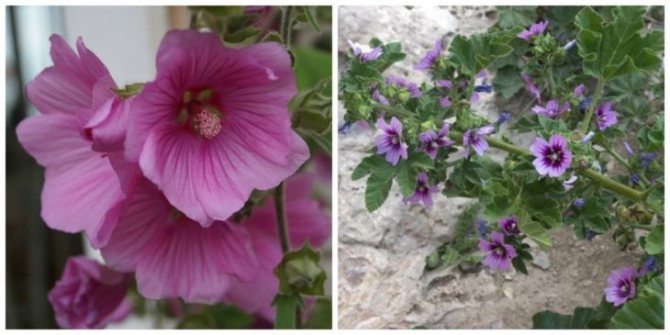

Choosing a place for planting a lavater in the open field
To facilitate the care of this unpretentious flower, you need to correctly place it on the site. To do this, you need to take into account two important factors - illumination and soil characteristics. Lavatera tolerates and even loves open sunlight and well-drained, loose and light soil. But this does not mean at all that the best and most fertile areas should be allocated for planting the lavater. She will grow well in more modest conditions. It is worth giving this flower the best sunny areas only if it is assigned the role of a decoratively significant element of garden design. In the absence of such conditions, it will = grow well in a little shade.
When choosing a place, you should also take into account that tall varieties are prone to lodging, so they need to be provided with supports or places for them near fences, gazebos, walls of garden buildings, etc.
Use in landscape design
The flower is great for single planting and creating compositions. Lavatera can be used in mixborders. The plant goes well with iris, verbena and sage. On lawns, such a flower can be a bright accent.
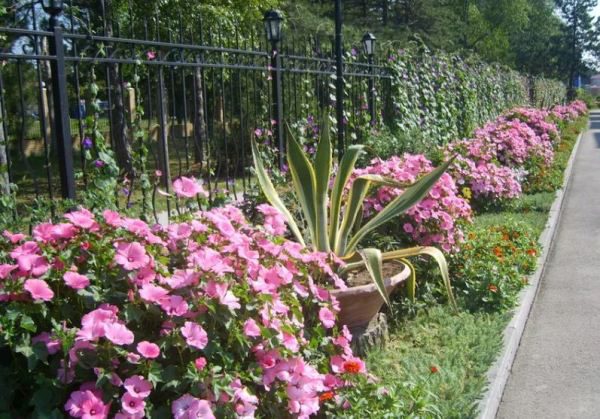

Lavatera looks good both in single landings and in group
Tall varieties of Lavatera are often used to decorate the trunk of a tree. Live screens look spectacular, they help to hide outbuildings or simply unattractive parts of the garden. Due to the wide range of colors, the perennial lavater will make the flower bed more contrasting.
Growing Lavater from seeds
The seed method of reproduction is the main and practically the only one practiced among gardeners. If potted specimens are sometimes divided vegetatively, then in the open field there is no need to do this. These flowers reproduce well and self-seeding. If planting in a new place is done for the first time, and there is a desire to get early flowering in the current year, then it is recommended to plant Lavatera on seedlings in early spring. This is especially true when it comes to its annual varieties.
Sowing seeds for seedlings in regions with a mild climate is best in March, in colder areas in early April.
You should not sow lavater on seedlings earlier than the indicated dates, since seedlings grow quickly, and this can create a problem.
Sowing in open ground should be carried out, respectively, in April and closer to May or in the first days of it. Small short-term frosts are not critical for these flowers.
Preliminary preparation of the site
A lot of preparation for planting a lavater is not required, it is enough to dig up the soil and you can make direct sowing with seeds in open ground. If you follow all the rules, it is recommended to pay for every 1 sq. M. a bucket of humus or compost with the addition of 2 tbsp. nitrophosphate. In the dug up soil, one-centimeter grooves are made, spilled with warm water and dry seeds are sown. From above, the bed is covered with a transparent (prerequisite!) Plastic wrap for light access. The first shoots should appear in about 1-2 weeks.
Planting Lavatera seedlings
As already noted, the seedling method is not necessary for the culture; it can be used only if you wish to bring the flowering time closer. The period when it is necessary to sow lavater for seedlings can be calculated, based on the fact that the time for the transfer of seedlings to the site will come about 2 months after sowing the seeds. Any kind of nutritious soil will do, and the box must be well drained.
Lavatera seedlings do not need a pick, and care for it is minimal.It should be remembered that insufficient watering is preferable to excessive watering, although it should be regular in the first weeks of growth.
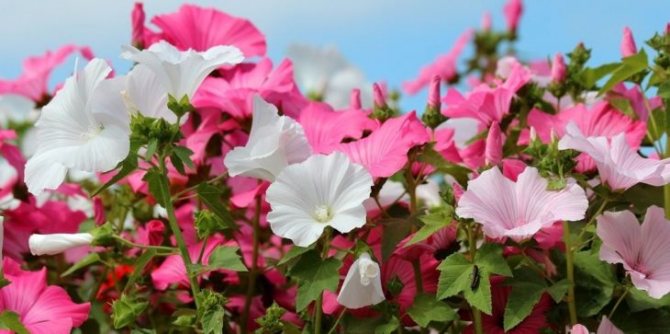

Care advice
Among flower growers, Lavatera is reputed to be a "lazy plant", and this title is fully justified: she does not need vigilant attention at all, and all the care of a beauty comes down to carrying out elementary agrotechnical measures:
Water the drought-resistant crop sparingly and not too often. In the heat, 2-3 buckets of water are poured under each bush weekly, and in normal weather the soil can be moistened every 10-12 days. Lavater is fed twice a season. In the spring, when the plants adapt to a new place, plantings are watered with a solution of nitrogen-containing fertilizers (1 tablespoon of urea and nitrophosphate per 10 liters of water). At the beginning of budding, the plants are fed with sodium sulfate and potassium sulfate, dissolved in water (1 tbsp. Spoon / 10 l - for each adult specimen). But! If you fertilized the soil well before planting, the first top dressing is not necessary. Until the bushes reach a height of 1 m, the soil under them is periodically loosened
In the future, the procedure is canceled so as not to injure the superficially located root system of plants. It is very important to pick off wilted Lavater inflorescences in a timely manner. In the rain, they turn into an unpleasant slimy mass and leave brown spots of burns on the foliage.
That's all the worries. Thanks to simple procedures, the plants will develop harmoniously and delight you with lush flowering until the coldest days.
End of flowering, collection of seeds
After the end of flowering, in place of wilted inflorescences, you can see round green boxes. To collect the seeds, you must wait until they are fully ripe. If the goal is to exclude self-seeding, they must be cut off immediately after flowering. A sign of seed maturity is the brown color of the fruit capsule, while the seeds from it easily spill out. Harvesting them for future use requires good drying.
The germination of the harvested seeds of lavater lasts up to 5 years.
Diseases and pests
Lavatera has a pretty good immunity against diseases and pests. Sometimes the flower is affected by garden aphids. To get rid of such a pest, it is recommended to use systemic preparations of Actara or means of combined action with Actellik.
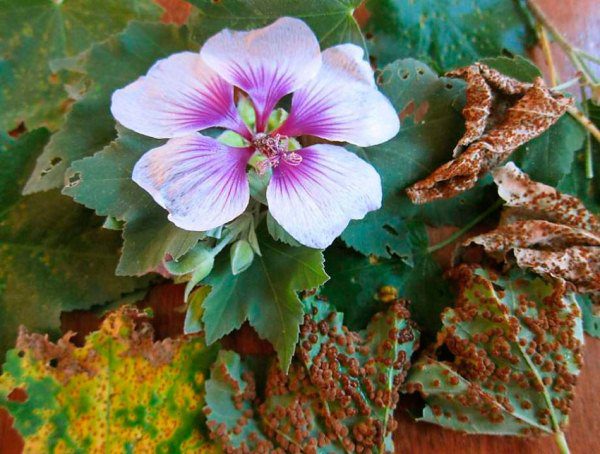

Signs of rust damage to Lavatera
When damaged by rust, the plant becomes covered with brown, brown or yellow spots. In this case, it is necessary to remove all the affected parts, and treat the plant itself with topaz, Bordeaux liquid or cuproxate. If the flower is completely damaged by rust, then it is best to simply remove it from the site and burn it.

